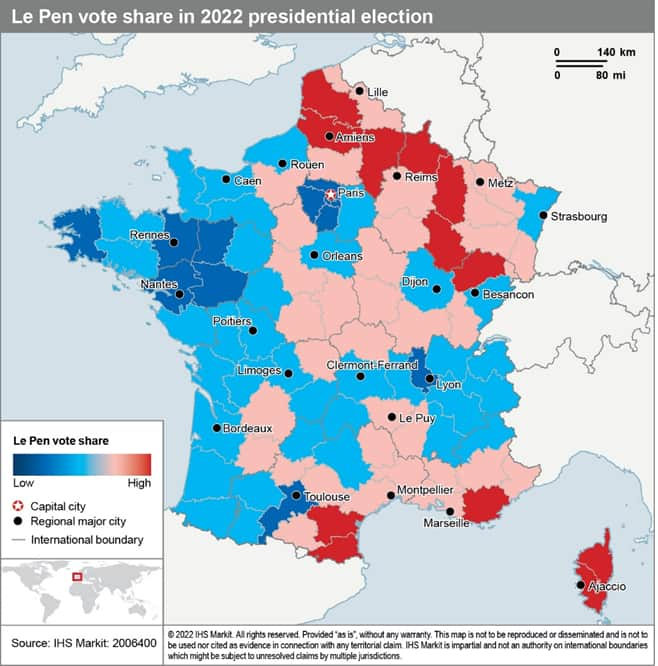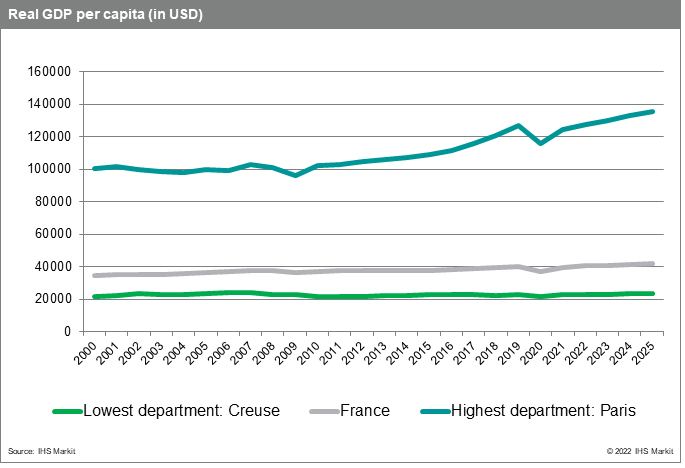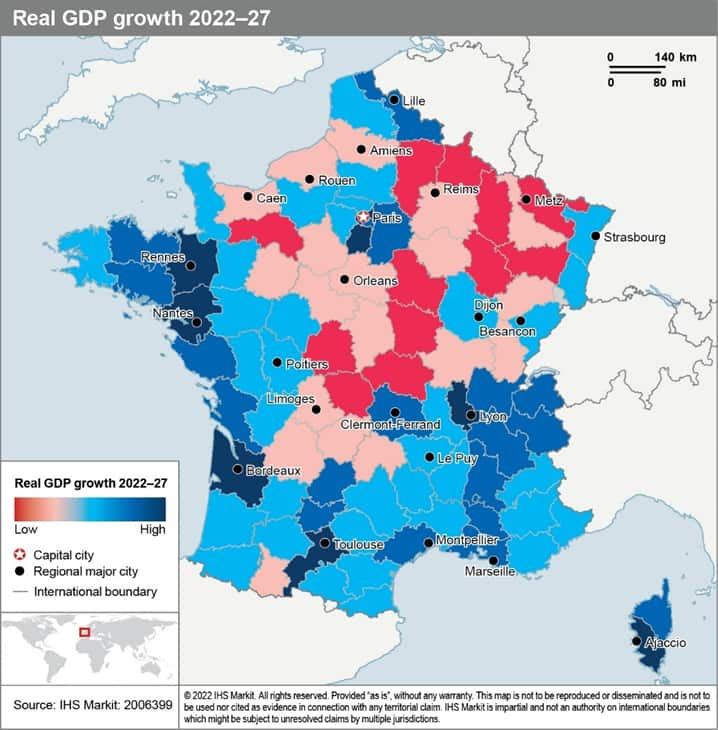Customer Logins
Obtain the data you need to make the most informed decisions by accessing our extensive portfolio of information, analytics, and expertise. Sign in to the product or service center of your choice.
Customer Logins
BLOG
Jul 18, 2022
Regional inequality in France: Impact on future political stability
France's presidential and legislative elections, held in April and June, have established a new political landscape for President Emmanuel Macron's second five-year mandate, with the political extremes having received increased support in both polls.
Although support for anti-establishment parties has also been boosted by non-economic factors such as concerns about immigration and crime, it tends to be stronger in regions that have underperformed in terms of economic growth since the last presidential elections. Departments that experienced a worse performance in per capita real GDP growth during the 2017-22 period showed, on average, higher levels of support for the RN (Rassemblement National: RN) than other regions.
Support for the RN is highly concentrated in rural or lower-income areas in the northeast, center and southwest of the country. Other than in Seine-Saint-Denis, Le Pen won in nine of the top 10 departments with the highest poverty rates in the country in the presidential election runoff on 24 April.

Regional inequalities have increased, favoring further political migration towards the political extremes
While France's real GDP per capita grew by 15.8% between 2000 and 2019, the national average masks significant regional disparities (see chart). As an illustration, real GDP per capita in Paris and Hauts de Seine, the top two departments in terms of real GDP per capita, rose by around 33% during the period. The measure however only increased by just 5% in Creuse, the department with the lowest real GDP per capita.

In absolute terms, the disparity in regional inequality is elevated with a strong concentration of economic activity. Out of France's 96 departments, the three richest departments (Paris, Hauts-de-Seine and Rhône) account for 22% of France's total GDP (although Paris' GDP per capita is overestimated due to people who work in the city but live outside the capital). By contrast, the bottom 10 departments contribute only 1.3% to France's total real GDP in 2022.
Regional inequality is likely to widen over the next five years
While GDP per capita is an imperfect measure of living standards, higher inflation and slowing economic growth is likely to have a particularly acute impact on lower-income households, at least over the two-year horizon, increasing the likelihood of violent protests in Paris and in the worst-performing areas, along with more frequent industrial action, during 2023 and 2024.
Projected real GDP growth for 2022-27 looks likely to reinforce the 2017-22 trend (see map below); Haute-Marne, Meuse, Vosges, and Ardennes are projected to register negative GDP growth. The share of votes for RN, or other far-right, far-left, or anti-establishment parties that may emerge by the next presidential election is therefore likely to remain high in these departments. Their performance is likely to be stronger if economic grievances, particularly those related to purchasing power and unemployment persist - or worsen - throughout during the 2022-27 period.

Due to structural weaknesses, high inflation, and a lack of major strategic development plans for poorer departments, regional policy is unlikely to reduce the growth gap versus wealthier departments, increasing the risk of further substantial change in the political landscape after the next electoral cycle.
Data pulled from Regional Explorer.
This article was published by S&P Global Market Intelligence and not by S&P Global Ratings, which is a separately managed division of S&P Global.
{"items" : [
{"name":"share","enabled":true,"desc":"<strong>Share</strong>","mobdesc":"Share","options":[ {"name":"facebook","url":"https://www.facebook.com/sharer.php?u=http%3a%2f%2fstage.www.spglobal.com%2fmarketintelligence%2fen%2fmi%2fresearch-analysis%2fregional-inequality-france-impact-future-political-stability.html","enabled":true},{"name":"twitter","url":"https://twitter.com/intent/tweet?url=http%3a%2f%2fstage.www.spglobal.com%2fmarketintelligence%2fen%2fmi%2fresearch-analysis%2fregional-inequality-france-impact-future-political-stability.html&text=Regional+inequality+in+France%3a+Impact+on+future+political+stability+%7c+S%26P+Global+","enabled":true},{"name":"linkedin","url":"https://www.linkedin.com/sharing/share-offsite/?url=http%3a%2f%2fstage.www.spglobal.com%2fmarketintelligence%2fen%2fmi%2fresearch-analysis%2fregional-inequality-france-impact-future-political-stability.html","enabled":true},{"name":"email","url":"?subject=Regional inequality in France: Impact on future political stability | S&P Global &body=http%3a%2f%2fstage.www.spglobal.com%2fmarketintelligence%2fen%2fmi%2fresearch-analysis%2fregional-inequality-france-impact-future-political-stability.html","enabled":true},{"name":"whatsapp","url":"https://api.whatsapp.com/send?text=Regional+inequality+in+France%3a+Impact+on+future+political+stability+%7c+S%26P+Global+ http%3a%2f%2fstage.www.spglobal.com%2fmarketintelligence%2fen%2fmi%2fresearch-analysis%2fregional-inequality-france-impact-future-political-stability.html","enabled":true}]}, {"name":"rtt","enabled":true,"mobdesc":"Top"}
]}





